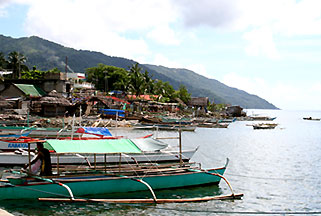UP Study Finds Toxic Metals in Rapu-Rapu Mine Spill
Sediments near the
mine tailings spillage in Rapu-Rapu Island, Albay province were found to
contain not just cyanide but also heavy metals namely, mercury, lead,
cadmium, chromium, and arsenic, which are poisonous to humans and the
environment.
By Dennis Espada
Bulatlat

Rapu-rapu island’s
shore, now contaminated by mine spill
PHOTO BY AUBREY SC MAKILAN |
Sediments near the mine tailing spillage
in Rapu-Rapu
Island, Albay province (some 550 kms from Manila) were found to contain
not just cyanide but also heavy metals that are poisonous to humans and
the environment.
A laboratory analysis conducted by the
Environmental Engineering Unit of the National Engineering Center of the
University of the Philippines in Quezon City revealed that all sediment
samples are “acidic” and tested positive for the presence of mercury,
lead, cadmium, chromium and arsenic, among others. The findings were
presented to the media last February 1.
|
The island-municipality hosts the
Rapu-Rapu Polymetallic Project operated by the Australian transnational
firm Lafayette Mining Limited—flaunted as the Macapagal-Arroyo
government’s “flagship” project to revitalize the mining industry.
Poisonous metals
The UP study was commissioned by the
Center for Environmental Concerns-Philippines (CEC), an ecological
research organization that led a fact-finding team last Nov. 12-13 to
probe the ecological implications of Lafayette’s mining operations in
Rapu-Rapu. The team visited the island’s Barangay Binosawan and collected
at least 34 sediment samples from ponds where water was believed to have
flowed from the mine site. The group also took samples of the remaining
mine tailings from the tailings pond to the shoreline.
Last October 11 and 31, mine wastes
contaminated with cyanide spilled to the sea allegedly triggering a fish
kill. The Department of Environment and Natural Resources (DENR) then
slapped Lafayette a fine of P10.7 million in violation of the Clean Water
Act early last month.
However, the study revealed that the water
was contaminated not only by cyanide. Tests revealed a sediment sample
that stores mercury at 0.999 part per million (ppm) was found near one of
the spots where the spillage took place. This is way beyond the
government’s allowable standard of 0.20 ppm for disposal of industrial
wastes.
CEC researcher Januar Ong said that the
study contradicted Lafayette’s claims that it was not using mercury in its
operations.
“Hindi dahilan ang hindi paggamit ng
minahan ng mercury kung bakit nagkaroon ng mas mataas na lebel ng
mercury sa mga isda sa panukatan ng
gobyerno dahil ang naturang mercury ay natural na nananatili sa ilalim ng
lupa at/o sa mga bato. Dahil sa pagmimina ng Lafayette, ang malawakang
paghuhukay, nailabas ang mga ito at dumaloy kasama ng mine tailings
patungong sapa at dagat,” (The company cannot argue that it does not
use mercury in its mining operations to escape responsibility for the high
levels of mercury found in fishes. In the course of its diggings,
Lafayette unearths mercury, which is naturally found in certain areas in
the soil and rocks, causing it to flow with the mine tailings towards
streams and the sea.) Ong said.
Lafayette is using the “cyanide leaching
method”, a rapid manner of extracting gold from the ore, Ong explained.
The UP study, he said, also validates an
earlier study made by the Ateneo de Naga University’s Institute of
Environmental Conservation and Research (Inecar), which revealed the
occurrence of acid mine drainage (AMD) in the area. AMD is polluted water
with high levels of iron, aluminum and sulfuric acid that appears
yellow-orange in color.
He also pointed out that the said metals
are natural parts of rocks excavated for mining. If these were brought to
the surface, he said, it could leak or mix with any type of water,
including the residents’ drinking source.
Andy Salatan, an instructor from UP’s
Institute of Chemistry,
said that mercury is a neuro-toxin that can induce cancer, brain damage
and abortion among pregnant women. Cadmium destroys the bones and internal
organs, while lead can break up the central nervous system. He thinks it
is possible for humans to ingest these metals by eating marine animals
like fish and shrimps that are caught within contaminated areas.
“Actually, ang mga metals na ‘to, tinanggal na sa mga experiments ng
General Chemistry dahil sa kanilang mga epekto (These metals
have been removed from experiments in General Chemistry because of its
effects),” he said.
Against large-scale
mining
Following the release of CEC’s report,
environmentalists and mine-affected people’s organizations has accelerated
their demand for the permanent closure of Lafayette’s mining operations in
Rapu-Rapu.
The anti-corporate mining alliance called
Defend Patrimony! (Movement Against Globalization of Mining Industry,
Plunder and Destruction) urged Lafayette to immediately rehabilitate the
affected areas, provide medical assistance and compensate the people of
Rapu-Rapu for loss of income due to the mining operations and mine spill.
Just recently, the group has found an ally
among leaders of the Roman Catholic Church. In its pastoral letter last
January 29, the Catholic Bishops Conference of the Philippines (CBCP)
appealed to the government to stop the 24 large-scale mining projects and
to scrap the Mining Act of 1995, a law that place the country’s mineral
resources under foreign control and exploitation.
Deploring the Macapagal-Arroyo
administration’s efforts to pressure and co-opt the CBCP into reversing
its stand against large-scale mining, Trixie Concepcion, spokesperson of
Defend Patrimony! stated, “What the people want is a mining policy that is
geared towards national industrialization and genuine development, which
guarantees environmental protection and respects human rights.”
“We are not against
mining per se. What we are opposing is the liberalization of mining…the
environmental tragedies now taking place far outweigh the claimed benefits
of corporate mining in the country,” Kalikasan-People’s Network for the
Environment (KPNE) national coordinator Clemente Bautista Jr. said.
Bulatlat
BACK TO
TOP ■
PRINTER-FRIENDLY VERSION ■
COMMENT
© 2006 Bulatlat
■
Alipato Publications
Permission is granted to reprint or redistribute this article, provided
its author/s and Bulatlat are properly credited and notified.